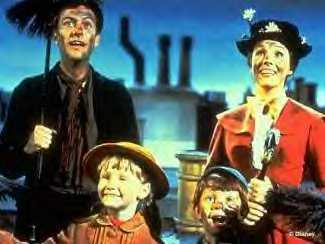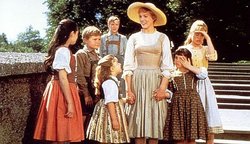Julie Andrews
|
|
Dame Julie Andrews, DBE (born October 1, 1935) is a British actress, singer, and author, best known for her starring roles in the musical films Mary Poppins (1964) and The Sound of Music (1965).
She was born Julia Elizabeth Wells in Walton-on-Thames, Surrey, England, the daughter of an actor and a pianist. Early on, her father recongized her rare, four octave coloratura soprano talent and enrolled her in voice lessons to develop her abilities. Her earliest public performances were during World War II, entertaining troops throughout the UK with fellow child star Petula Clark. She made her stage debut at an early age, appearing in London's West End in 1947. She graduated through radio (on the show Educating Archie) and to the production of The Boy Friend in 1953 (which transferred to Broadway the same year, giving Andrews her American debut). During her run in the musical, she starred in Rodgers & Hammerstein's television adaptation of Cinderella.
In 1956, composers Frederick Loewe and Alan Jay Lerner cast Andrews as Eliza Doolittle opposite Rex Harrison's Henry Higgins in My Fair Lady (a musical adaptation of George Bernard Shaw's Pygmalion). The show became the smash hit of the year and Andrews an overnight sensation. In 1961, the composers again cast her in a period musical: as Guenevere in Camelot opposite Richard Burton and newcomer Robert Goulet. As was her previous show, it was a smash hit.
When she lost the starring role in the film of My Fair Lady to Audrey Hepburn, she received the consolation of the starring role in Walt Disney's Mary Poppins (1964), winning the Academy Award for Best Actress as a result. Studio chief Jack Warner had told Andrews he didn't feel she packed the gear to play in My Fair Lady. After beating Hepburn for the Oscar, Andrews got a measure of "sweet revenge". In her acceptance speech, she said "I would like to thank Jack Warner for his faith in me". At the Grammy Awards of 1965 she and her co-stars won the Grammy Award for Best Album for Children for Mary Poppins. She was nominated for an Academy Award again, the following year, for her role as Maria von Trapp in The Sound of Music (1965), and thus became, briefly, one of the most sought-after stars in Hollywood. As a result, she appeared in the three-hour epic Hawaii, co-starring with Max von Sydow, and Alfred Hitchcock's Torn Curtain with Paul Newman (both in 1966), and Thoroughly Modern Millie (1967), with Mary Tyler Moore and Carol Channing.

Her film career was revived by director Garry Marshall, who cast her in The Princess Diaries and its sequel, both of which proved to be major box office hits. She has also starred in two made-for-television movies based on the character of Eloise, the moppet who lives at the Plaza Hotel in New York City. In 2004, she lent her voice to the role as Queen Lilian to the highly successful animated hit Shrek 2, the sequel to the 2001 smash.
In the 2000 New Year's Honours she was made a DBE, becoming Dame Julie Andrews. Since then she has been struggling to recover her singing voice, following a throat operation, but had a short tour of the USA at the end of 2002 with Christopher Plummer, Charlotte Church, Max Howard, and the Royal Philharmonic Orchestra. In 2005 she agreed to direct a Toronto revival of The Boy Friend, the Broadway musical in which she made her debut in America.
Dame Julie's career is said to have suffered from typecasting, as her two most famous roles in Mary Poppins and The Sound of Music cemented her image as a "sugary sweet" personality best known for working with children. Her roles in Blake Edwards's films could be seen as an attempt to break away from this image: in 10 her character is a no-nonsense career woman; in Victor/Victoria she plays a woman pretending to be a male, and, perhaps most notoriously, in S.O.B. she plays a character very similar to herself, who agrees (with some pharmaceutical persuasion) to "show my boobies" in a scene in the film-within-the-film. For this last performance, late night king Johnny Carson thanked Andrews for "showing us that the hills were still alive", alluding to her most famous line from the title song of The Sound of Music.
Julie received Kennedy Center Honors in 2001. She also appears in the 2002 List of "100 Great Britons" sponsored by the BBC and voted for by the public. For her contribution to the motion picture industry, Julie Andrews has a star on the Hollywood Walk of Fame at 6901 Hollywood Blvd.
Julie has written several children's books, under the name Julie Andrews Edwards. Perhaps the most well-known is The Last of the Really Great Whangdoodles (ISBN 0064403149).
By her 1959-1967 marriage to Tony Walton, the British director, she had one daughter, Emma Kate Walton.
Filmography
- Mary Poppins (1964)
- The Americanization of Emily (1964)
- Salzburg Sight and Sound (1965) (short subject)
- The Sound of Music (1965)
- Torn Curtain (1966)
- Hawaii (1966)
- Think Twentieth (1967) (short subject)
- Thoroughly Modern Millie (1967)
- The Singing Princess (1967) (voice)
- Star! (1968)
- Darling Lili (1970)
- The Moviemakers (1971) (short subject)
- The Tamarind Seed (1974)
- 10 (1979)
- Little Miss Marker (1980)
- S.O.B. (1981)
- Victor/Victoria (1982)
- Trail of the Pink Panther (1982) (Cameo)
- The Man Who Loved Women (1983)
- That's Life! (1986)
- Duet for One (1986)
- A Fine Romance (1991)
- Relative Values (2000)
- The Princess Diaries (2001)
- Unconditional Love (2002) (Cameo)
- Shrek 2 (2004) (voice)
- The Princess Diaries 2: Royal Engagement (2004)
TV Work
- Cinderella (1957)
- Julie and Carol at Carnegie Hall (1962)
- The Julie Andrews Show (1965)
- A World in Music with Julie Andrews and Harry Belafonte (1969)
- Julie and Carol at Lincoln Center (1971)
- The Julie Andrews Hour (1972-1973)
- Julie on Sesame Street (1973)
- Julie and Dick at Convent Garden (1974)
- Julie and Jackie: How Sweet It Is (1974)
- Julie Andrews: One Step Into Spring (1978)
- Julie Andrews: The Sound of Christmas (1987)
- Julie & Carol: Together Again (1989)
- Julie Andrews in Concert (1990)
- Our Sons (1991)
- Julie (1992) (canceled after 3 months)
- Victor/Victoria (1995)
- One Special Night (1999)
- On Golden Pond (2001)
- Eloise at the Plaza (2003)
- Eloise at Christmastime (2003)

